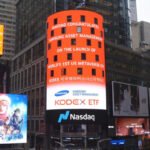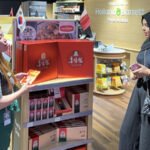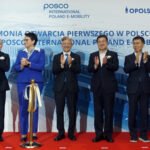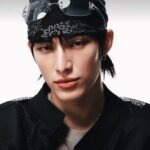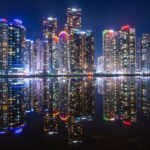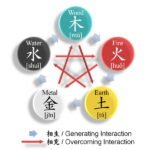 |
For Korean workers detained for seven days after being swept up at the Georgia battery plant construction site, the word “human rights” was nowhere to be found. On September 14, Yonhap News obtained the “detention diary” of one worker, Mr. A, which described in detail the horrific conditions inside the detention facility and the human rights violations that occurred. Mr. A had entered the United States legally on a B-1 visa (a short-term business visa for travel, meetings, or training). During a two-month business trip for meetings and training, he was arrested with his wrists tied in zip ties. Arrest Without Explanation or Miranda Rights On September 4, at around 10 a.m., agents from U.S. Immigration and Customs Enforcement (ICE) stormed the site. They first searched the Korean workers, who were wearing helmets and safety shoes. Mr. A did not have time to grab his ID or passport. At 1:20 p.m., ICE distributed forms labeled “Warrant Arrest for Alien” and ordered the workers to fill in the blanks. There was no explanation of the documents and no mention of Miranda rights. The atmosphere was so intimidating that there was no way to carefully translate and understand the English line by line. “The workers thought they would be released if they just submitted the papers,” Mr. A wrote. After handing them in, red bracelets were strapped onto their wrists. The agents then began confiscating belongings. They forced the workers to place their phones and personal items into mesh bags. Realizing the seriousness of the situation, Mr. A secretly turned on his phone, sent a quick message to his family and company — “I don’t think I’ll be reachable” — and then shut it off again. After waiting over nine hours, he was loaded into a transport vehicle with his wrists bound tightly by zip ties. Those taken earlier were shackled around the waist, legs, and wrists. Inside the transport van, there was a toilet that reeked of urine, and the air conditioning was left off. Packed Into a 72-Person Cell At first, the detained workers were crammed into a temporary cell holding 72 people. There were five such rooms, and detainees were rotated among them. The room had rows of bunk beds and six communal toilets (four toilets, two urinals). There was no clock and no windows. Mattresses were moldy. A thin cloth near the toilet offered scant privacy. Many held in their bodily needs rather than endure the humiliation. “I wasn’t given even a towel,” Mr. A wrote. “A friend gave me one, and I slept under it.” The room was freezing, and detainees tried to keep warm by wrapping themselves in towels. Some even microwaved towels to generate warmth. The drinking water provided smelled foul. Only later were toothbrushes, toothpaste, blankets, and deodorant distributed. On the fourth day, after completing intake procedures, Mr. A was moved into a two-person room. But because of the sheer number of detainees, some never left the 72-person cells. Pen and paper were forbidden, but Mr. A managed to sneak some on the fourth day and began writing his diary. Mocked as “North Korea” and “Rocket Man” On the third day of detention (September 6), ICE finally began interviews. First, agents distributed “voluntary departure” documents and told the detainees to sign. Many signed despite anxiety over the word “illegal” stamped across them. After waiting long hours, Mr. A was finally taken outside for the first time in three days to the interview room. After fingerprinting, two ICE officers reviewed his file. Their first question was, “What kind of work did you do?” He answered: business meetings and training. One officer then asked if he was from “South Korea.” When he said yes, the agents laughed among themselves and made jokes: “North Korea… Rocket Man” (the nickname former President Trump gave Kim Jong-un). “I was furious that they were mocking me,” Mr. A wrote. “But I stayed quiet, afraid it might affect my paperwork.” At the end of the interview, he asked, “I entered properly on a B-1 visa and was acting within its purpose. Why was I arrested?” The ICE officer replied, “I don’t know. But the people above us think you’re illegal.” Some officers reportedly admitted to other detainees that ICE had made mistakes. Consulate Urges: “Just Sign and Go Home” On the fourth day (September 7), four officials from the Korean Consulate General and Foreign Ministry visited the detainees. According to Mr. A, the consular officials told them: “What matters most is going home. Sign whatever they give you, no matter what.” They warned that if a dispute arose, detainees could remain imprisoned for four months to several years. The consular staff explained that signing would mean forced deportation, visa cancellation, and repatriation via chartered flight. That night at 11 p.m., Mr. A finally went through full intake: changing into prison clothing, having his height, weight, and blood pressure recorded. By 3 a.m., he was placed into a two-person cell. The building held 50 rooms, each with a toilet, desk, and bunk beds. On the fifth day, September 8, Foreign Ministry staff visited again. “I was angry,” Mr. A wrote, “because no one could explain why coming in on a B-1 visa was suddenly considered illegal. It felt like all they cared about was pushing us to sign voluntary departure forms and get us out quickly.” After that, the detainees were left waiting without clear information. Their release was delayed, nerves fraying as days dragged on. Finally, in the early hours of September 11, buses took the workers from the detention facility to Atlanta airport. At 3:30 p.m. Korea time, 330 workers — 316 Koreans and 14 foreign nationals — landed back in Korea on Korean Air flight KE9036, ending their nightmarish ordeal. submitted by /u/Freewhale98 |
Related Posts
Latest News from Korea
- Samsung Asset retains top rank on Q3 asset league table with $71 bn ETF portfolioSamsung Asset Management launches the world’s first US metaverse ETF on the Nasdaq in December 2021 South Korea’s asset management industry swelled in the third quarter, buoyed by a rally in domestic equities and surging investor demand for exchange-traded funds (ETFs). Samsung Asset Management Co. is poised to become the country’s first asset manager to surpass 100 trillion won ($71… Read more: Samsung Asset retains top rank on Q3 asset league table with $71 bn ETF portfolio
- China’s young consumers drive Korean health supplement boomGinseng and other health food account for a quarter of KT&G’s sales South Korea’s exports of health functional food or health supplements have surged sharply in recent months, fueled by Chinese millennials and Gen Z eager to emulate the looks and lifestyles of K-pop idols. Exports of products such as red ginseng tonics, vitamins and omega-3 capsules reached $43.9 million… Read more: China’s young consumers drive Korean health supplement boom
- Hyundai cuts IONIQ 5 prices in US to deal with end of EV tax subsidyThe Hyundai IONIQ 5 (Courtesy of Hyundai Motor America) Hyundai Motor Co., South Korea’s top automaker, on Wednesday lowered the prices of the IONIQ 5 lineup in the US to as automakers in the world’s third-largest electric vehicle market scrambled to deal with the Trump administration’s elimination of the tax credit benefit of up to $7,500 for EV buyers. Hyundai… Read more: Hyundai cuts IONIQ 5 prices in US to deal with end of EV tax subsidy
- Posco International builds Polish motor core plant; Mexico factory due by year-endPOSCO International holds a ceremony to mark the completion of its Polish drive motor core plant in Brzeg, Opole Region, Poland, on Oct. 1, 2025 POSCO International Corp., the energy and trading unit of South Korea’s steel giant POSCO Holdings Inc., said on Thursday it has inaugurated its first European production base for electric vehicle components in Poland, stepping up… Read more: Posco International builds Polish motor core plant; Mexico factory due by year-end
- Korea’s battery material maker Enchem scraps $143 mn US plant planEnchem’s electrolyte plant in the US state of Georgia (File photo) Enchem Co., a South Korean battery material maker, has scrapped its plan to invest $143 million to build a plant in the US due to the protracted downturn in the world’s third-largest electric vehicle market, industry sources in Seoul said on Wednesday. Enchem, the world’s No. 4 electrolyte manufacturer,… Read more: Korea’s battery material maker Enchem scraps $143 mn US plant plan
Latest Entertainment from Korea
- 82MAJOR’s Bold Fashion Evolution in ESQUIRE Korea October 2025 Pictorial Preview Sets Trends from Runway to StreetPhoto Credits: ESQUIRE Korea. Great M Entertainment “Where vulnerability meets edge, tomorrow’s icons are forged.” 82MAJOR’s pictorial preview for ESQUIRE Korea’s October 2025 issue is less a photoshoot and more a meticulously crafted fashion thesis—dramatized on the bodies of K-pop’s brightest new icons. Where typical editorials might trade in safe homage, this shoot carves out new ground: sculptural tailoring is… Read more: 82MAJOR’s Bold Fashion Evolution in ESQUIRE Korea October 2025 Pictorial Preview Sets Trends from Runway to Street
- MAMAMOO Solar Stuns in SKM Media October 2025 Cover with Elegant Pictorial Blending K-pop Star Power and Fashion EdgePhoto Credits: SKM Media. RBW Entertainment For the October 2025 issue of SKM Media, MAMAMOO’s Solar steps into a world of bold elegance and refined artistry, capturing the balance between confidence and quiet allure. Known for her commanding stage charisma, Solar transforms effortlessly into a modern muse before the camera—her gaze layered with warmth and intention, her posture telling a story… Read more: MAMAMOO Solar Stuns in SKM Media October 2025 Cover with Elegant Pictorial Blending K-pop Star Power and Fashion Edge
- Lee Hyeri Redefines Modern Elegance in Max Mara for Marie Claire Taiwan October 2025 Issue with Effortless Autumn CharismaPhoto Credits: Marie Claire Taiwan. Max Mara Sublime Artist Agency Lee Hyeri unveils a new facet of her effortless sophistication in the October 2025 issue of Marie Claire Taiwan, gracing the cover in Max Mara’s latest collection. The shoot blends cinematic minimalism with rich textural layering, emphasizing soft beige tones, sculptural outerwear, and understated confidence—perfectly aligned with the Italian house’s timeless… Read more: Lee Hyeri Redefines Modern Elegance in Max Mara for Marie Claire Taiwan October 2025 Issue with Effortless Autumn Charisma
- KATSEYE’s Power Play: i-D 375 “The Beta Issue” Digital Covers Reimagine K-Pop Style with Fierce Pictorials and Symbolic VisionPhoto Credits: i-D Magazine. HYBE Geffen Records KATSEYE continues their meteoric rise in global music and fashion with a striking set of pictorials for the i-D 375 “The Beta Issue,” a digital cover that merges youth culture, high style, and innovative editorial vision. The six-member girl group is featured in bold, monochrome ensembles, most notably showcasing sleek black silhouettes that… Read more: KATSEYE’s Power Play: i-D 375 “The Beta Issue” Digital Covers Reimagine K-Pop Style with Fierce Pictorials and Symbolic Vision
- Baby DON’T Cry Stuns in NYLON JAPAN November 2025 Issue Preview with Bold Pictorial and Rising K-Pop Fashion EdgePhoto Credits: NYLON JAPAN. P Nation The highly anticipated November 2025 issue of NYLON JAPAN has set the stage for one of the most intriguing fashion previews this autumn, spotlighting the rising K-pop group Baby DON’T Cry in a dazzling pictorial spread. Exuding both rebellion and refinement, the photos capture the group balancing effortlessly between edgy streetwear and runway-level polish, giving fans… Read more: Baby DON’T Cry Stuns in NYLON JAPAN November 2025 Issue Preview with Bold Pictorial and Rising K-Pop Fashion Edge
Learn People & History of Korea
- The Evolution of Busan: A Historical Journey Through South Korea’s Second Largest Metropolitan CityAncient Beginnings: The Founding of Busan Busan, known as the second largest metropolitan city in South Korea, has a rich history that dates back to ancient times. The earliest recorded existence of Busan can be traced to the Goryeo Dynasty, where it was referenced as a vital coastal settlement. Its strategic location along the southeastern coast of the Korean Peninsula… Read more: The Evolution of Busan: A Historical Journey Through South Korea’s Second Largest Metropolitan City
- The Evolution of Pyongyang: A Journey Through History, Economy, and Political DynamicsIntroduction to Pyongyang Pyongyang, the capital city of North Korea, serves as a prominent symbol of the nation’s history and culture. Geographically located on the banks of the Taedong River, in the southwest part of the country, Pyongyang is situated within a strategic area that has historically facilitated trade and cultural exchange. The city’s origins can be traced back to… Read more: The Evolution of Pyongyang: A Journey Through History, Economy, and Political Dynamics
- The Evolution of Seoul: From Ancient Korea to Modern Metropolis and BeyondAncient Beginnings: The Founding of Seoul The city of Seoul, known today as the vibrant capital of South Korea, has ancient roots that trace back to the Three Kingdoms period of Korea, specifically the kingdoms of Baekje and Silla. Evidence suggests that Seoul was originally established as a settlement given its strategic geographical advantages. Nestled within the Han River basin,… Read more: The Evolution of Seoul: From Ancient Korea to Modern Metropolis and Beyond
- Exploring Korean Traditional Games in Squid Game: From Season 2 to Upcoming Season 3Introduction to Korean Traditional Games Korean traditional games have long been an integral part of the country’s cultural landscape, offering more than mere entertainment. These games, which range from simple children’s pastimes to complex community activities, hold significant cultural significance and often serve as a means of preserving history and promoting social interaction. Rooted in centuries of tradition, these games… Read more: Exploring Korean Traditional Games in Squid Game: From Season 2 to Upcoming Season 3
- Unveiling the Past and Present of Saju: The Art of Korean Fortune TellingIntroduction to Saju Saju, a traditional Korean fortune-telling practice, is an intricate art that seeks to interpret an individual’s fate based on their birth date and time. The term “Saju” translates to “four pillars” in English, referring to the four critical components derived from these time markers: year, month, day, and hour. This method holds significant cultural value within South… Read more: Unveiling the Past and Present of Saju: The Art of Korean Fortune Telling

